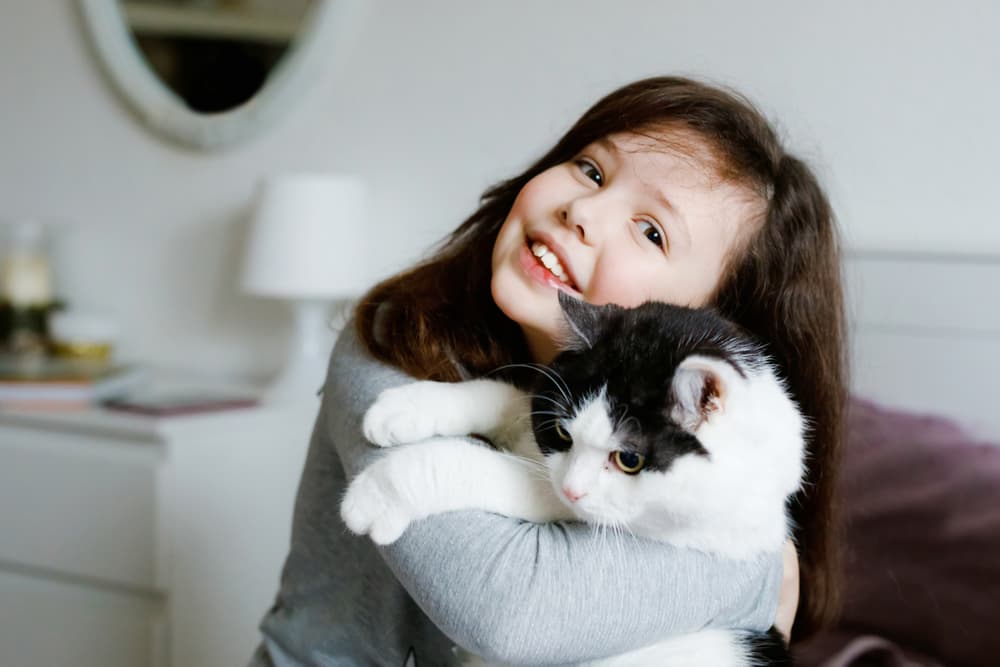Are Cats Ticklish?

Look up “tickle” in Merriam-Webster, and you’ll find this: “to touch (a body part, a person, etc.) lightly so as to excite the surface nerves and cause uneasiness, laughter, or spasmodic movements.”
For some people, especially young kids, being tickled can cause a giddy and giggly reaction. For many others, it’s an action they despise – likely because it stimulates the same area of the brain as both our pain and fight or flight responses. But whichever camp they fall into, humans are all familiar with the concept of tickling.
And as it turns out, other animals may respond to it, too. Tickling can make apes laugh just like (some) people do. It can prompt a dog to “smile” by lifting up the corners of their mouth. It’s even been found to decrease anxiety in rats. But what about our feline friends? Are cats ticklish?
Are Cats Ticklish? Experts Weigh In

The short answer: we’re not sure if tickling a cat causes any real reaction.
We do know that mammals tend to experience two types of ticklish touch:
- Knismesis: a light, almost itchy-feeling sensation (and the one that dogs, horses, sharks, meerkats and others respond to)
- Gargalesis: causes humans (and gorillas and rats) to dissolve into writhing laughter
With that said, no one is fully sure whether cats can be tickled or what it might feel like to them.
“It’s really hard to tell if animals are ticklish or not, because they do not react like we do to tickles: laughing, giggling, wiggling around,” says Joanna Wachowiak-Finlaison, a certified animal behavior consultant and owner of High Five Animal Training. “Ticklish, to me, sounds like a very human concept.”
Wachowiak-Finlaison also notes that since “most of their body is covered in fur, cats are not really going to feel a very light touch the way we do on our skin.”
All that hair makes Dr. Marci L. Koski, certified feline behavior/training consultant and owner of Feline Behavior Solutions, further question whether cats can feel a ticklish touch. “Having fur all over their bodies could create a tickling kind of feeling if cats were sensitive to that, which could be problematic for them,” she says.
Common Cat Tickle Spots

Wachowiak-Finlaison believes that the most ticklish way a cat reacts is the little twitches and flick-away response they have when you lightly touch the tips of their ears. She also suspects that a cat is more likely to feel a tickly sensation in other spots where their skin is exposed, like the nose.
For general touch and petting, she says most cats enjoy it when you gently rub the tips or backs of your fingers along their jawline, which mimics the way cats greet each other. “This is the polite place to pet them,” she says. “If I’m touching a new cat, I always let it rub against my fingers.”
The chest is also a preferred spot for most cats, she says. Just stay away from the belly, as almost all cats hate having it touched.
Do Cats Like to Be Tickled?

Whatever sensation cats are getting from a light, tickly touch, Wachowiak-Finlaison says how they feel about it is “definitely an individual thing,” just as it is for humans. Cats all have different preferences for the type of touch they like best, where they prefer it to be, and how much they like to be touched in general.
“That’s why it really pays to know your cat’s body language,” she adds, noting that Sphinxes may be one cat breed that has even more distinct reactions to touch since they aren’t covered in long hair.
How to Tickle a Cat Without Creating Stress

Whether you’re tickling or just petting a cat, it’s important to monitor their response carefully. Wachowiak-Finlaison even recommends a “consent test,” which works like this: pet your cat a few times, then stop. Leave your hand hanging and see what the cat does next. If they lean into it again, asking for more, then you know they’re liking it and can keep going.
Wachowiak-Finlaison also underscores the importance of touching (or tickling) cats more softly than you would a dog, as well as always “watching for any tiny sign that the cat isn’t enjoying it.” If you see any indication that your cat isn’t into the way they’re being touched or tickled, stop right away.
When NOT to Tickle a Cat

You certainly don’t want to test out tickling if your cat is scared, upset or has already made it clear that they’re not in a hands-on mood.
Even if your cat is relaxed and calm – and seems to enjoy petting in a particular moment – it’s crucial to keep an eye out for signs that things have shifted. Wachowiak-Finlaison says the first signal that a cat is not enjoying your touch is usually a twitch at the tip of their tail. Also look out for them pushing back or flattening their ears slightly, or shifting their body weight away from you. Ideally, you’ll have gotten the hint before they get to larger signs of dismay, like hissing, spitting, and big tail swishes.
“My most important message is to learn your cat’s body language and always watch your cat,” Wachowiak-Finlaison notes. “Don’t just keep petting your cat mindlessly. Pay close attention to the small signs.”









